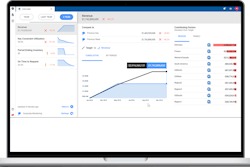
As retailers, distributors and manufacturers strive to create memorable customer experiences, personalized products have become standard fare and even table stakes in industries such as consumer products. Business models now incorporate interchangeable module designs, hub-and-spoke configurations, assemble-on-demand designs and tiered pricing. To accommodate the complexity that comes with personalized offerings, companies are forced to re-think their supply chain planning and execution strategies. Fortunately, analytics-driven supply chain solutions help take the guesswork out of anticipating customer trends and synchronizing the arrival of inventory.
Intelligent Orchestration
Orchestrating the arrival of parts, components, custom-assembled products and personalized packaged goods is no easy feat. When the consumer places an order for a customized product, whether it is shoes, furniture, a team T-shirt or a tailored-to-measure suit, several one-off actions are set into motion. Supply chain network solutions can play a vital role in each step, creating the streamlined efficiency essential for profitability. Without the use of advanced technology that connects and integrates trading partners, attempts to offer personalized products can be costly and high-risk, jeopardizing the customer relationship if the product ships late or does not meet expectations.
Software, particularly solutions built to orchestrate complex multi-enterprise processes, can help manage the end-to-end process. First, a configuration tool is often valuable for creating the design, pricing, drawings and specifications for the product. Configuration tools can be incorporated into the sales process (online or in-store), at the distributor level, or as the interface with the manufacturer, depending on the product and industry. For example, do-it-yourself centers often assist customers with ordering custom doors and windows. They use an in-store configuration tool to help visualize the design, estimate the price, and create a detailed work order. The special order is then sent to the supplier that mills the made-to-order items.
The supplier or manufacturer may use modular designs and interchangeable components, assembling elements as needed to make the product personalized. In high tech, for example, production of laptops often involves supplier segmentation strategies that deliver goods targeting specific channels of customers, while final assembly is completed by an outside party to deliver add-on features and accessories ordered by the customer. The base product may be the same for all orders across that customer segment, but the customer receives a laptop that was custom-made.
In both examples, and countless others, personalization complicates the inventory requirements and the timing of production and supplier deliveries. Customers expect orders quickly. Even custom orders, such as made-to-measure window treatments and accessory-loaded vehicles, are expected to be shipped in days or weeks, not months. Inventory of the necessary components is essential. But, increasing the safety-stock levels and over-stocking for “just-in-case” needs can unnecessarily tie up capital, hurting cashflow. Predicting “right-sized” inventory levels is one of the main challenges faced by companies that make and sell personalized products.
Predictive Business Intelligence
Guessing customer preferences for product features is impossible. Who can say what percentages of customers will choose a matt or polished finish, indigo blue or sage green, sand texture or cobblestone? Making inventory and supply chain decisions based on a hunch or instinct, rather than predictive data science, is highly risky. This is how some retailers end up with warehouses full of obsolete products in styles, finishes and colors that were panned by consumers.
Intelligent supply chain technology is transforming the way enterprises project and prepare for modern commerce, including highly personalized products that customers demand. Artificial intelligence (AI) and machine learning (ML), make it possible to anticipate trends and confidently project styles, finishes, accessories and features that will appeal to certain regions and demographics. Data science can also help predict the delivery times of inventory with greater precision and accuracy than ever. Numerous influencing factors, from weather to the age range of shoppers, can be monitored to identify trends and anticipate likely outcomes. Predictive intelligence uses algorithms and machine learning to help managers project inventory levels needed for promotions and seasonal events.
Monitoring the Intelligent Network
Anticipating trends is only one part of the challenge. The resources and data for assembly and packaging must also be in the right place and right time for the finished goods to ship on time. Whether the personalized product ships to the retailer for pick-up or direct to the consumer, the shipping routes vehicles and containers take should be tracked to ensure smooth transport. Sensors connected with Internet of things (IoT) technology help relay valuable information back to supply chain managers. Possible delays, from factors such as extreme weather, political unrest, tariffs, strikes or mechanical failures, can be identified early — when there is still time to intervene.
Orders can be shifted from one supplier to another to avoid availability issues. Shipments on cargo carriers can be rerouted to avoid dangerous weather or unrest in port cities. Transport can be scheduled for air, rather than ground, when timing is critical. Real-time visibility to the connected network makes this level of agility possible. In advanced, self-driven supply chains, software solutions can perform diagnostics, prescribe solutions and trigger autonomous response. Visibility – in real-time – combined with actionable insights, is key.
Proven Results
Innovation-driven enterprises have brought the industry past the early-adopter stage of supply chain visibility solutions. But visibility alone has limited value. Predicting trends and prescribing actions is not just nice to have, but a necessity for remaining competitive. Companies must keep pace with customer expectations for personalized products to achieve their profit goals, despite the complexity of made-to-order manufacturing and highly-personalized products.
Companies that embrace innovation and invest in digitization initiatives can take advantage of connected supply chain networks, warehouse planning tools, AI-driven analytics and predictive data science to anticipate opportunities on the demand and supply sides of the supply chain and take action.
A retailer planning a multi-state promotion will need to plan how much inventory to ship to each store. If the product has options, such as multiple color combinations, the inventory demands could be intensive and costly. Historical patterns can be used to predict new sales, but that alone is seldom enough. Managers may overcompensate for sales uncertainty by setting margins lower than necessary or creating high inventory buffers. On the other hand, an intelligence-driven supply chain that combines department-level agility and network-wide data analytics can operate more effectively and profitably. Factors such as high traffic to the website, social media dialogues, competitive pricing and advance orders, can point to specific regional spikes or pockets of high demand that can be quantified and anticipated.
By applying predictive science, companies can make more accurate promotion forecasts, manage related transportation schedule dependencies and confidently ship goods at lower rates in advance of holidays and weekends. Costs are minimized because they aren’t simply reacting to unforeseen demand or overstocking safety inventory in every style, color and finish possible.
Final Take-away
Commerce today involves many highly personalized products. This is likely to increase, as retailers, distributors and manufacturers all strive to create memorable customer experiences and build loyalty through value-added offerings. It is up to the enterprise, therefore, to transform supply chain processes and deploy software solutions that simplify the operational complexity of personalized product offerings. Now is the time to invest in solutions that make managing personalized products and the self-driven supply chain network possible. Companies can deliver the speed and service customers expect, with greater efficiencies that help them boost profits. Custom product offerings can be high-risk and low margin, if the details are not managed carefully. Being prepared with the right inventory, in the right place, at the right time, is essential.



















![Pros To Know 2026 [color]](https://img.sdcexec.com/mindful/acbm/workspaces/default/uploads/2025/08/prostoknow-2026-color.mduFvhpgMk.png?ar=16%3A9&auto=format%2Ccompress&bg=fff&fill-color=fff&fit=fill&h=135&q=70&w=240)